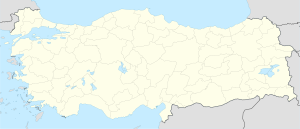Գորդիոն
From Wikipedia, the free encyclopedia
Գորդիոն (հուն․՝ Γορδιον), Փռյուգիայի հնագույն մայրաքաղաքը։ Գորդիոնը տեղակայված է եղել Սաքարյա գետի աջ ափին՝ Սաքարյա և Փորսուք գետերի մոտեցման վայրի մոտ, Փոլաթլըից 21 կմ դեպի հյուսիս-արևմուտք, Անկարայից 90 կմ հեռավորության վրա, Անկարայի մարզի Յասսըհոյուք գյուղում, Անկարա-Էսքիշեհիր ճանապարհից ոչ հեռու։ Ըստ ավանդության՝ քաղաքի հիմնադրել է Փռյուգիայի առաջին թագավոր Գորդիասը[1]։
Քաղաքի առաջին պեղումները կատարվել են 1900 թվականին[2], հետագայում՝ 1951-1973 թվականներին[3]։ Հայտնաբերվել են հզոր պաշտպանական պարիսպներ քարից ու հում աղյուսից, հում աղյուսից բնակելի տներ տնային տնտեսության մեծաթիվ առարկաներով, արհեստագործական գործիքներ և զենք։ Հայտնաբերվել է նաև լայանածավալ նեկրոպոլ։
Խճանկար

Ռոդնի Ս. Յանգը (Rodney S. Young) 1951 թվականին հնագիտական պեղումների ժամանակ գտել է մ․թ․ա․ 8-5-րդ դարերի խճանկարներ, որոնք համարվում են անմշակ գետաքարից խճանկար պատրաստելու տեխնիկայի հնագույն նմուշները։
Այդ խճանկարը ամենահինն է և տարածքով ամենամեծը (10×11 մ)։ Խճանկարի ստեղծման համար օգտագործվել է մուգ կապույտ, մուգ կարմիր և սպիտակ գույների գետաքարեր, որոնք դրվել են առանց որոշակի կարգի՝ զարդանախշերի (մեանդր, շեղանկյուն, սվաստիկա) քաոսային դասավորված հատվածների ձևով, որոնց համար հավանաբար հիմք են ծառայել այն զարդանախշերը, որ օգտագործվել են տեքստիլում։
Ծանոթագրություններ
Գրականություն
Արտաքին հղումներ
Wikiwand - on
Seamless Wikipedia browsing. On steroids.


